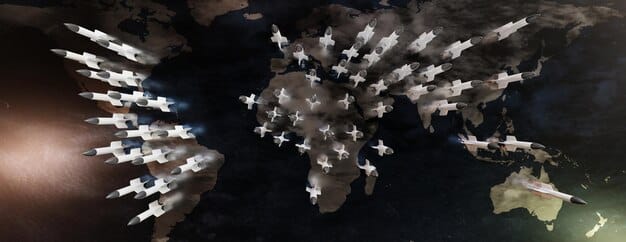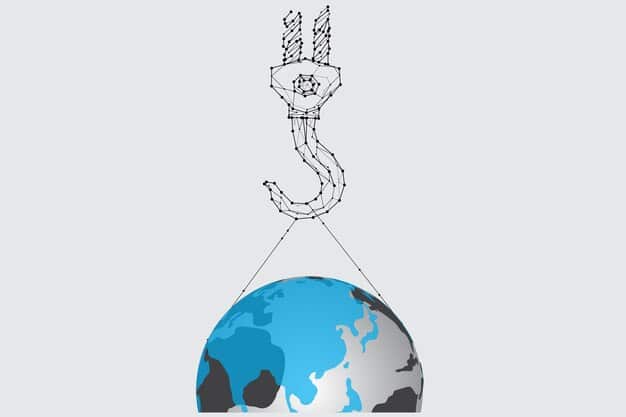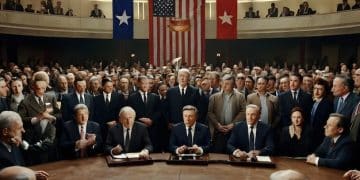US Defense Spending Increase: Global Stability Impact Explained

The recent 7% increase in US defense spending presents a multifaceted impact on global stability, potentially escalating arms races, reconfiguring alliances, and influencing geopolitical power dynamics while also projecting strength and maintaining deterrence.
The recent announcement of a 7% increase in US defense spending has reverberated across international capitals, sparking intense debate and speculation. This significant budgetary adjustment is not merely an internal fiscal decision; it carries profound implications for geopolitical balances, alliance structures, and the very nature of global stability. Understanding its potential ripple effects requires a nuanced look at defense economics, international relations, and strategic foresight.
Understanding the Context of Increased US Defense Spending
The decision to boost US defense spending by 7% is multifaceted, stemming from a confluence of domestic priorities and evolving international challenges. This increment isn’t an isolated event but rather part of a broader strategic recalibration in Washington, responding to perceived threats and technological shifts. It reflects an ongoing commitment to maintaining military superiority, a cornerstone of US foreign policy for decades.
This substantial rise is driven by several key factors. Geopolitical tensions, particularly with resurgent powers and rogue states, play a significant role. The need to modernize military capabilities, including investments in cutting-edge technologies like artificial intelligence, cyber warfare, and hypersonic weapons, also consumes a considerable portion of the increased budget. Furthermore, inflationary pressures, coupled with rising personnel costs and maintenance for a vast global military footprint, contribute to the ballooning figures.
Geopolitical Imperatives Driving Expenditure
The security landscape is constantly shifting, and the US, as a global superpower, faces continuous pressure to adapt its defense posture. Key geopolitical imperatives include:
- Great Power Competition: The rise of strategic competitors necessitates sustained investment to maintain a qualitative and quantitative edge.
- Regional Conflicts: Ongoing conflicts in various parts of the world demand readiness and rapid deployment capabilities.
- Technological Superiority: The imperative to stay ahead in military technology, ensuring future dominance on the battlefield and in cyberspace.
The strategic rationale behind this spending is rooted in the concept of deterrence. By projecting overwhelming power and technological sophistication, the US aims to dissuade potential adversaries from aggressive actions, thereby preserving peace and stability, albeit from a position of strength. This proactive approach seeks to shape the international order in line with US interests and values.
The allocation of these funds will likely see substantial investment in research and development, procurement of new platforms, and enhancement of logistical capabilities. This means more advanced aircraft, naval vessels, and ground systems, as well as a greater focus on integrating these assets through sophisticated command and control networks. The underlying goal is to ensure the US military remains agile, responsive, and capable of operating across multiple domains, from conventional warfare to hybrid threats.
Potential Ramifications for Global Arms Races
A significant increase in US defense spending invariably prompts a reaction from other nations, particularly major military powers. This dynamic frequently manifests as an “arms race,” where countries feel compelled to boost their own military expenditures to maintain a perceived balance of power or to counter what they see as an escalating threat. The 7% increase could accelerate existing trends, transforming strategic competition into a more pronounced arms build-up.
Historically, periods of increased spending by one dominant power have often been mirrored by others. This isn’t merely about numerical parity; it’s about technological advancement and strategic capabilities. Nations may prioritize specific areas of defense, leading to a specialized arms race in critical domains like cyber warfare, anti-access/area denial (A2/AD) capabilities, or long-range precision strike. The ripple effect could be global, extending beyond direct adversaries to include regional powers seeking to bolster their own security.
Escalation Dynamics and Regional Implications
The direct consequence of an accelerated arms race could be heightened instability in volatile regions. As countries acquire more sophisticated weaponry, the risk of miscalculation or accidental escalation increases. Each nation’s defensive move might be perceived as an offensive threat by its neighbors, creating a feedback loop of suspicion and preparation for conflict.
This could lead to:
- Increased Military Modernization: Nations accelerate efforts to upgrade their arsenals, leading to new generations of weaponry.
- Deployment of Advanced Systems: More sophisticated weapons platforms deployed closer to potential flashpoints.
- Enhanced Military Exercises: More frequent and larger scale military drills, which can be seen as provocative.
For instance, a country might invest heavily in naval power, prompting its maritime neighbors to do the same. Or, a focus on air superiority by one nation could lead its rivals to invest in advanced air defense systems. These cycles of action and reaction can be difficult to de-escalate once they gain momentum, creating enduring tensions and a higher potential for conflict. The economic burden of such an arms race can also divert resources from critical social and developmental programs, posing long-term challenges to national prosperity.
Impact on Alliances and Partnerships
The 7% increase in US defense spending is likely to have a dual impact on its existing alliances and partnerships. On one hand, it could be perceived as a reaffirmation of US commitment to global security, potentially strengthening the confidence of allies who rely on American military power for deterrence and collective defense. On the other hand, it might also intensify calls for greater burden-sharing, pushing allies to increase their own defense contributions or invest in specific capabilities that complement US forces.
The message conveyed by this spending is crucial for alliance cohesion. A robust US military budget can reassure allies that the US has the resources and political will to honor its commitments, particularly in regions facing immediate threats. This could lead to more integrated defense planning, joint exercises that are larger in scope, and deeper intelligence sharing. Allies may feel more secure in their alignment with the US, trusting in its capacity to act decisively in a crisis.
Reinforcing Commitment or Demanding More?
The narrative around increased spending can shift from reassurance to expectation. The US may leverage its heightened investment to press allies for similar commitments, particularly those who have historically fallen short of defense spending targets, such as NATO’s 2% of GDP guideline. This can create internal friction within alliances but may also lead to a stronger, more capable collective defense posture.
Potential outcomes include:
- Increased Allied Contributions: Nations may feel compelled to raise their own defense budgets to show solidarity and ensure interoperability.
- Specialized Role Development: Allies may be encouraged to develop niche capabilities, enhancing the overall strength of the alliance in specific areas.
- Enhanced Interoperability: Greater emphasis on standardized equipment and procedures to ensure seamless joint operations.
Beyond traditional alliances, the spending increase could also influence emerging partnerships. Countries seeking to counter regional threats or diversify their security relationships might view a stronger US as an attractive partner. This could lead to new security agreements, joint training initiatives, and technology transfers, thereby expanding the network of US influence and cooperation globally. The long-term effect is a more complex web of interconnected security relationships, each influenced by the broader American defense posture.
Economic Repercussions and Global Distribution of Wealth
A 7% increase in US defense spending, translating to billions of dollars, has significant economic implications both domestically and internationally. Domestically, it could stimulate growth in the defense industry, create jobs in manufacturing and technology, and drive innovation. However, it also represents a substantial allocation of national resources that could otherwise be directed towards social programs, infrastructure, or other economic sectors. The opportunity cost of such spending is a constant point of debate within the US.
Globally, the economic repercussions are more nuanced. For countries that are major exporters of military hardware and technology, or those that host US military bases, there might be direct economic benefits through contracts and job creation. Conversely, nations already struggling economically might find themselves under pressure to increase their own defense spending in response, diverting scarce resources from development or essential services. This could exacerbate existing economic disparities and, in some cases, contribute to social unrest.
Fiscal Impact on National Economies and Trade
The sheer scale of US defense spending can distort global defense markets, influencing pricing, demand, and technological standards. Nations looking to upgrade their militaries may have to contend with higher prices or more limited availability of advanced systems if US domestic demand consumes a significant portion of production capacity. This can also affect technology transfer agreements and intellectual property rights, as the US seeks to protect its strategic advantages.
Potential economic shifts:
- Defense Industry Boom: Significant boost for US defense contractors, leading to increased production and exports.
- Resource Allocation Debate: Global discussion on where national resources are best spent – defense versus development.
- Impact on Trade Balances: Changes in the export and import of defense-related goods and services.
Furthermore, the increased spending could impact global financial markets. If the US funds this increase through borrowing, it could contribute to an increase in the national debt, potentially affecting global interest rates or the value of the dollar. The perception of US economic stability, often intertwined with its fiscal health, can have far-reaching effects on international investment and trade flows. The economic consequences are thus not limited to the defense sector but extend across the broader financial landscape.
Technological Advancements and Their Implications
A core component of any significant defense spending increase is often a focus on technological advancement. The 7% rise in US defense spending is highly likely to be channeled into research and development (R&D) of cutting-edge military technologies, aiming to maintain a qualitative edge over potential adversaries. This pushes the boundaries of innovation, not just in specific weapon systems but also in areas like artificial intelligence (AI), quantum computing, biotechnology, and advanced materials.
The pursuit of technological superiority is a perpetual race, and increased funding allows the US to invest more heavily in emerging capabilities that could redefine future warfare. This includes sophisticated surveillance systems, autonomous weapons platforms, advanced cyber offensive and defensive tools, and next-generation communication networks. The goal is to create capabilities that are not only more effective but also more resilient and adaptable to evolving threats.
Dual-Use Technologies and Ethical Considerations
Many military technologies have “dual-use” potential, meaning they can be adapted for civilian applications. Breakthroughs in defense R&D can therefore spur broader technological innovation, contributing to advancements in areas like robotics, satellite technology, and data analytics that benefit society as a whole. However, this also raises ethical questions about the responsible development and deployment of technologies that could have profound impacts on humanity.
Key technological shifts:
- Accelerated AI Integration: AI becomes more pervasive in military decision-making, logistics, and combat.
- Directed Energy Weapons: Development of laser and microwave weapons for defense and offense.
- Advanced Cyber Capabilities: Sophistication of tools for cyber warfare, impacting critical infrastructure.
The focus on these advanced technologies also has implications for non-state actors and smaller nations. While these capabilities are initially developed by major powers, the proliferation of certain dual-use components or the reverse-engineering of advanced systems can potentially empower a wider range of actors. This makes the landscape of future conflicts even more complex, requiring new doctrines for deterrence and defense. The ethical considerations surrounding autonomous weapon systems, in particular, will continue to be a significant point of international debate.

US Defense Posture in a Multipolar World
The 7% increase in US defense spending is a clear signal of its intent to maintain a robust defense posture in an increasingly multipolar world. Unlike the unipolar moment that followed the Cold War, the international system is now characterized by multiple centers of power, each with its own interests and capabilities. In this complex environment, US defense spending is designed not just to address current threats but also to project influence and shape the geopolitical landscape for decades to come.
This elevated spending reinforces the US’s position as a primary security provider and a technological leader. It allows for sustained presence in key strategic regions, the ability to respond to crises rapidly, and the capacity to undertake large-scale operations if necessary. The aim is to ensure that even in a multipolar world, the US retains the necessary leverage to deter aggression, protect its interests, and support its network of allies and partners. It represents an acknowledgment that military power, while not the sole instrument of foreign policy, remains a critical one.
Strategic Competition and Power Projection
In a multipolar context, the competition for influence is dynamic and multifaceted. Military strength, backed by substantial investment, becomes a crucial component of a nation’s overall power projection. The US increase signals its readiness to engage in this competition across various domains, from conventional military might to cyber and space capabilities. It is a proactive stance intended to prevent rivals from gaining decisive advantages.
Manifestations of revised posture:
- Forward Deployment: Sustained or increased deployment of forces in key strategic theaters.
- Global Reach: Enhanced capacity for rapid deployment and sustained operations worldwide.
- Tailored Deterrence: Development of specific deterrent strategies for different adversaries and contexts.
The challenge for the US in a multipolar world is to balance its own security needs with the broader goal of global stability. While a strong military can deter conflict, an overly aggressive or unilateral posture could inadvertently provoke a backlash or accelerate arms races. Therefore, the strategic deployment and utilization of this enhanced military capacity will be just as important as the spending itself. It requires shrewd diplomacy, strong alliances, and a clear understanding of the evolving global power dynamics to ensure that increased military strength contributes to, rather than undermines, international peace and security.
Ethical Considerations and Long-Term Implications
Beyond the immediate geopolitical and economic impacts, a sustained 7% increase in US defense spending raises profound ethical considerations and has significant long-term implications for global society. The allocation of such vast resources to military purposes inevitably invites scrutiny regarding humanitarian priorities, international cooperation, and the very definition of security in the 21st century.
One primary ethical concern is the opportunity cost: what critical global challenges, such as climate change, poverty, public health crises, or education, could be addressed with resources equivalent to a substantial military budget increase? While national defense is paramount for sovereignty, the balance between military investment and social welfare spending often leads to intense debate. From a global perspective, a heavy focus on military might can divert attention and resources from shared human challenges that require collective action.
The Pursuit of Peace Through Enhanced Military Power
The paradox lies in the argument that increased defense spending is a means to achieve peace through deterrence. It is posited that a strong US military prevents larger conflicts, thereby saving lives and preserving stability. However, this approach can also be viewed as perpetuating a cycle of military buildup, where perceived security is achieved through fear and the constant threat of retaliation, rather than through diplomacy, cooperation, and conflict resolution.
Long-term implications could include:
- Shifting Global Norms: A preference for military solutions over diplomatic ones could become more entrenched.
- Resource Exhaustion: Continuous military spending can strain natural resources and environmental sustainability.
- Impact on Future Generations: Legacy of debt and potential for prolonged global instability.
Furthermore, the development and deployment of advanced weapon systems, particularly autonomous ones, present complex ethical dilemmas regarding accountability, the value of human life, and the potential for unintended escalation. The long-term implications extend to the psychological impact on societies living under perpetual threat of conflict, the erosion of trust between nations, and the potential for technological innovation to be overwhelmingly directed towards destructive rather than constructive ends. Addressing these ethical considerations requires a global dialogue that transcends national interests and focuses on the shared imperative of human well-being and sustainable peace.

| Key Point | Brief Description |
|---|---|
| ⚔️ Arms Race Escalation | The increase may spur other nations to raise defense budgets, fueling global arms races. |
| 🤝 Alliance Dynamics Shift | Could strengthen alliances but also increase pressure for allied burden-sharing. |
| 💰 Economic Ramifications | Impacts defense industry growth, resource allocation, and global financial markets. |
| 🔬 Tech Advancement Drive | Significant investment in AI, cyber warfare, and other advanced military technologies. |
Frequently Asked Questions About US Defense Spending
The increase is driven by geopolitical tensions, the need for military modernization, technological advancements, and rising operational costs. It reflects a strategic response to evolving global challenges and a commitment to maintaining military superiority and deterrence against potential adversaries in a complex world order.
A significant US spending boost could provoke other major powers to increase their own military budgets, potentially accelerating arms races. This dynamic can lead to heightened instability, particularly in volatile regions, as nations acquire more sophisticated weaponry, increasing the risk of miscalculation and conflict escalation.
Economically, it could stimulate the US defense industry and create jobs. For other nations, it might mean pressure to increase their defense spending, diverting resources from development. It also influences global defense markets, potentially affecting prices and the availability of advanced military technologies worldwide, impacting trade balances.
The increase could strengthen alliances by reassuring partners of US commitment and capabilities, leading to deeper integration. However, it may also intensify US calls for greater burden-sharing from allies, potentially creating friction but ultimately aiming for a more robust and capable collective defense posture among allied nations.
Long-term ethical concerns include the opportunity cost of diverting resources from vital global issues like climate change or poverty, and the potential for perpetuating cycles of military buildup. It also raises dilemmas about prioritizing military solutions over diplomatic ones and the implications of advanced weapon systems on humanitarian principles and trust among nations.
Conclusion: Navigating a New Era of Global Security
The 7% increase in US defense spending marks a significant pivot in global security dynamics. Far from being a simple budgetary adjustment, it is a strategic declaration with far-reaching consequences that will reshape alliances, accelerate technological races, and redefine the global distribution of power. While aimed at maintaining deterrence and ensuring national security, its ripple effects could also lead to heightened tensions and compel other nations to re-evaluate their own defense postures, potentially fostering a more militarized international environment. The path forward demands shrewd diplomacy, thoughtful resource allocation, and a perpetual commitment to finding a balance where military strength supports, rather than undermines, the foundational principles of international cooperation and enduring peace. This budgetary decision is a stark reminder that in an interconnected world, the actions of one powerful nation reverberate across the entire global stage, necessitating a constant, vigilant assessment of their impact on collective stability and shared prosperity.





